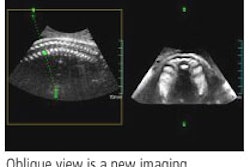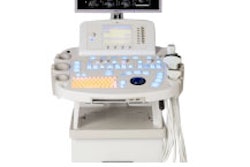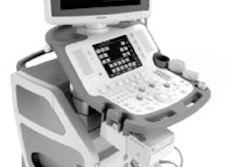Ultrasound has made significant inroads into many areas of medicine, but breast cancer screening is not one of them, according to a presenter at the 2006 American Society of Breast Surgeons meeting in Baltimore last week.
Although ultrasound may be more sensitive than mammography in identifying breast cancer in some cases, it shouldn't routinely be incorporated into breast cancer screening programs just yet, said Dr. Edgar Staren, Ph.D.
"I'm not sure that the data have indicated it's ready for primetime," said Staren, a surgical oncologist and senior vice president of medical affairs at Cancer Treatment Centers of America in Zion, IL.
In his talk, Staren outlined what he considered the strengths and weaknesses of breast ultrasound.
US advantages
Mammographic cancer screening has been credited with saving lives, but the modality may miss 10% to 15% of breast cancers. In addition, its low sensitivity in women with dense breasts -- younger women and about a third of those over 40 -- is well-known.
In addition to better sensitivity, ultrasound does have several other advantages, Staren pointed out. It is relatively inexpensive (especially compared to MRI); doesn't require radiation; and is a well-tolerated, noninvasive exam.
During the early stages of ultrasound in the breast, the modality turned in a high false-positive rate compared to mammography, he added. As ultrasound equipment improved substantially, the possibility of using ultrasound for breast cancer screening arose and certain subgroups emerged for which the benefit was more significant. Several studies in the late 1980s found that ultrasound alone caught breast tumors that mammography couldn't see in 0.1% of patients, Staren said.
A 1995 study showed that ultrasound found incidental cancers in 0.3% of women, and the majority of these cases were in women with dense breasts. Another study in 1999 confirmed that 3 in 1,000 women with dense breasts would have cancer identified by ultrasound alone.
A 1998 paper demonstrated that ultrasound screening was more effective in women with a high risk of breast cancer, such as those with a family history of breast cancer. In these women, ultrasound identified cancer not found by mammography at a rate of 6 in 1,000, whereas in average-risk women the rate was 2 in 1,000, he explained.
A 2000 study utilizing whole-breast ultrasound in women diagnosed with breast cancer, half of whom had dense breasts, found additional tumors by ultrasound alone in 15% of the women. A study of sonographic screening following breast cancer surgery found that 1.2% of patients had incidental cancers even though their mammogram was negative.
"So clearly, (ultrasound is) something you can't ignore," Staren said.
US pitfalls
One major issue with ultrasound is that it's "highly operator-dependent," Staren said.
Various protocols for optimizing breast sonography have been proposed, but the skill and training level of the individual performing the test makes a difference as well, he added.
In certain populations such as women with a high risk for breast cancer, other modalities may win out over ultrasound. Several studies have shown that in women with BRCA1 and BRCA2 genetic mutations, which put them at higher risk for breast cancer, MRI clearly came out ahead of ultrasound as a screening tool, Staren said.
The main obstacle, though, is that the clinical significance of additional cancers found with sonography is unknown, Staren said. Until a clear outcome benefit is established for routine ultrasound breast cancer screening, it is unlikely to be widely accepted.
Hopefully, the current American College of Radiology Imaging Network study (ACRIN 6666) to evaluate ultrasound screening in women with dense breasts will provide some answers, Staren said. As of April 2006, protocol 6666 had completed data accrual and was continuing with follow-up.
"There may be an appropriate subpopulation of women for whom the benefits from screening breast ultrasound do outweigh the risks," Staren said. "However, further studies, some of which are ongoing, are needed to better define the appropriate target population as well as to see its effects on patient outcomes make a clinically significant difference."
By Crystal Phend
AuntMinnie.com contributing writer
April 13, 2006
Related Reading
Auto breast US handily spots lesions in early study, January 13, 2006
Lesion size, diameter, and location affect breast US interpretation, November 28, 2005
MRI best for familial breast cancer detection, December 16, 2005
Copyright © 2006 AuntMinnie.com



















